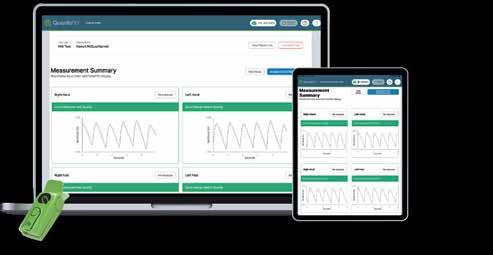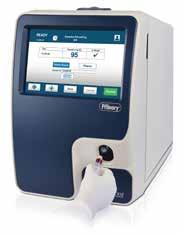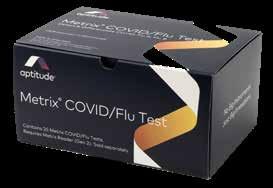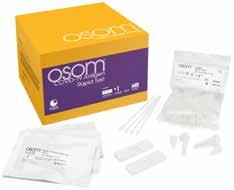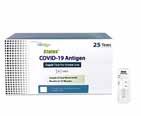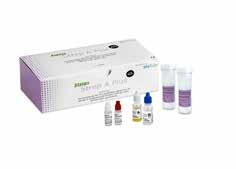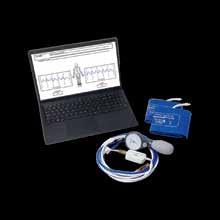OPDIVO QVANTIG™
(nivolumab and hyaluronidase-nvhy) injection, for subcutaneous use
Brief Summary of Prescribing Information. For complete prescribing information consult official package insert.
INDICATIONS AND USAGE
Advanced Renal Cell Carcinoma (RCC)
• In combination with cabozantinib, for the first-line treatment of adult patients with advanced RCC.
• For the treatment of adult patients with advanced RCC who have received prior anti-angiogenic therapy.
Adjuvant Treatment of Melanoma
• For the adjuvant treatment of adult patients with completely resected Stage IIB, Stage IIC, Stage III, or Stage IV melanoma.
Neoadjuvant and Adjuvant Treatment of Resectable Non-Small Cell Lung Cancer (NSCLC)
• In combination with platinum-doublet chemotherapy, for the neoadjuvant treatment of adult patients with resectable (tumors ≥4 cm or node positive) NSCLC and no known epidermal growth factor receptor (EGFR) mutations or anaplastic lymphoma kinase (ALK) rearrangements, followed by OPDIVO QVANTIG (nivolumab and hyaluronidase-nvhy) as monotherapy in the adjuvant setting after surgical resection.
Metastatic NSCLC
• For the treatment of adult patients with NSCLC with progression on or after platinum-based chemotherapy. Patients with EGFR or ALK genomic tumor aberrations should have disease progression on FDA-approved therapy for these aberrations prior to receiving OPDIVO QVANTIG.
Limitations of Use: OPDIVO QVANTIG is not indicated in combination with ipilimumab for the treatment of metastatic NSCLC.
Squamous Cell Carcinoma of the Head and Neck (SCCHN)
• For the treatment of adult patients with recurrent or metastatic squamous cell carcinoma of the head and neck with disease progression on or after platinum-based therapy.
Urothelial Carcinoma (UC)
• For the adjuvant treatment of adult patients with UC who are at high risk of recurrence after undergoing radical resection of UC.
• In combination with cisplatin and gemcitabine, for the first-line treatment of adult patients with unresectable or metastatic UC.
• For the treatment of adult patients with locally advanced or metastatic UC who:
• have disease progression during or following platinum-containing chemotherapy.
• have disease progression within 12 months of neoadjuvant or adjuvant treatment with platinum-containing chemotherapy.
Esophageal Cancer
• For the adjuvant treatment of completely resected esophageal or gastroesophageal junction cancer with residual pathologic disease in adult patients who have received neoadjuvant chemoradiotherapy (CRT).
• For the treatment of adult patients with unresectable advanced, recurrent, or metastatic esophageal squamous cell carcinoma (ESCC) after prior fluoropyrimidine- and platinum-based chemotherapy.
DOSAGE AND ADMINISTRATION
OPDIVO QVANTIG is for subcutaneous use only in the abdomen or thigh. Do not administer intravenously.
OPDIVO QVANTIG is to be administered by a healthcare professional only.
Recommended Dosages for OPDIVO QVANTIG as Monotherapy
Advanced RCC, Metastatic NSCLC, SCCHN, Locally Advanced or Metastatic UC, ESCC, Adjuvant Treatment of Melanoma, Adjuvant
Treatment of UC, and Adjuvant Treatment of Resected Esophageal or Gastroesophageal Junction Cancer
• 600 mg nivolumab and 10,000 units hyaluronidase every 2 weeks OR 1,200 mg nivolumab and 20,000 units hyaluronidase every 4 weeks until disease progression or unacceptable toxicity.
Recommended Dosages for OPDIVO QVANTIG in Combination with Other Therapeutic Agents
Advanced RCC
• 600 mg nivolumab and 10,000 units hyaluronidase every 2 weeks OR 1,200 mg nivolumab and 20,000 units hyaluronidase every 4 weeks until disease progression, unacceptable toxicity, or up to 2 years.
• In combination with cabozantinib 40 mg orally once daily without food until disease progression or unacceptable toxicity.
Neoadjuvant and Adjuvant Treatment of Resectable NSCLC
• Neoadjuvant: 900 mg nivolumab and 15,000 units hyaluronidase with platinum-doublet chemotherapy on the same day every 3 weeks until disease progression or unacceptable toxicity, for up to 4 cycles.
• Adjuvant: 1,200 mg nivolumab and 20,000 units hyaluronidase every 4 weeks until disease progression, recurrence, or unacceptable toxicity, for up to 13 cycles (up to 1 year).
First-Line Unresectable or Metastatic UC
• 900 mg nivolumab and 15,000 units hyaluronidase every 3 weeks in combination with cisplatin and gemcitabine on the same day for up to 6 cycles.
• After completing up to 6 cycles of combination therapy: 600 mg nivolumab and 10,000 units hyaluronidase every 2 weeks OR 1,200 mg nivolumab and 20,000 units hyaluronidase every 4 weeks until disease progression, unacceptable toxicity, or up to 2 years from first dose.
Refer to the respective Prescribing Information for each therapeutic agent administered in combination with OPDIVO QVANTIG (nivolumab and hyaluronidase-nvhy) for the recommended dosage information, as appropriate.
CONTRAINDICATIONS
None.
WARNINGS AND PRECAUTIONS
Severe and Fatal Immune-Mediated Adverse Reactions
OPDIVO QVANTIG is a combination of a monoclonal antibody that belongs to a class of drugs that bind to either the programmed death-receptor 1 (PD-1) or the PD-ligand 1 (PD-L1), blocking the PD-1/PD-L1 pathway, thereby removing inhibition of the immune response, potentially breaking peripheral tolerance, and inducing immune-mediated adverse reactions, and an endoglycosidase used to increase the dispersion and absorption of co-administered drugs when administered subcutaneously. Important immune-mediated adverse reactions listed under Warnings and Precautions may not include all possible severe and fatal immune-mediated reactions.
Immune-mediated adverse reactions, which may be severe or fatal, can occur in any organ system or tissue. Immune-mediated adverse reactions can occur at any time after starting treatment with a PD-1/PD-L1 blocking antibody. While immune-mediated adverse reactions usually manifest during treatment with PD-1/PD-L1 blocking antibodies, immune-mediated adverse reactions can also manifest after discontinuation of PD-1/PD-L1 blocking antibodies.
Early identification and management of immune-mediated adverse reactions are essential to ensure safe use of PD-1/PD-L1 blocking antibodies. Monitor patients closely for symptoms and signs that may be clinical manifestations of underlying immunemediated adverse reactions. Evaluate liver enzymes, creatinine, and thyroid function at baseline and periodically during treatment. In cases of suspected immune-mediated adverse reactions, initiate appropriate workup to exclude alternative etiologies, including infection. Institute medical management promptly, including specialty consultation as appropriate.
Withhold or permanently discontinue OPDIVO QVANTIG depending on severity [see Dosage and Administration (2 3) in full Prescribing Information] In general, if OPDIVO QVANTIG requires interruption or discontinuation, administer systemic corticosteroid therapy (1 to 2 mg/kg/day prednisone or equivalent) until improvement to Grade 1 or less. Upon improvement to Grade 1 or less, initiate corticosteroid taper and continue to taper over at least 1 month. Consider administration of other systemic immunosuppressants in patients whose immune-mediated adverse reactions are not controlled with corticosteroid therapy. Toxicity management guidelines for adverse reactions that do not necessarily require systemic steroids (e.g., endocrinopathies and dermatologic reactions) are discussed below.
Immune-Mediated Pneumonitis
OPDIVO QVANTIG can cause immune-mediated pneumonitis, which is defined as requiring use of steroids and no clear alternate etiology. In patients treated with other PD-1/PD-L1 blocking antibodies, the incidence of pneumonitis is higher in patients who have received prior thoracic radiation.
Immune-mediated pneumonitis occurred in 2.8% (7/247) of patients receiving OPDIVO QVANTIG (nivolumab and hyaluronidasenvhy), including Grade 3 (0.8%) and Grade 2 (2.0%) adverse reactions. Pneumonitis led to permanent discontinuation of OPDIVO QVANTIG in 1.6% and withholding of OPDIVO QVANTIG in 1.6% of patients.
Systemic corticosteroids were required in 100% (7/7) of patients with pneumonitis. Pneumonitis resolved in 2 7 % of the 7 patients. Of the 4 patients in whom OPDIVO QVANTIG was withheld for pneumonitis, 2 reinitiated OPDIVO QVANTIG after symptom improvement; of these, 1 (50%) had recurrence of pneumonitis.
Immune-Mediated Colitis
OPDIVO QVANTIG can cause immune-mediated colitis, defined as requiring use of corticosteroids and no clear alternate etiology. A common symptom included in the definition of colitis was diarrhea. Cytomegalovirus (CMV) infection/reactivation has been reported in patients with corticosteroid-refractory immune-mediated colitis. In cases of corticosteroid-refractory colitis, consider repeating infectious workup to exclude alternative etiologies.
Immune-mediated colitis occurred in 2.8% (7/247) of patients receiving OPDIVO QVANTIG, including Grade 3 (0.4%) and Grade 2 (2.4%) adverse reactions. Colitis led to withholding of OPDIVO QVANTIG in 2.0% of patients.
patient
Systemic corticosteroids were required in 100% (7/7) of patients with colitis. Colitis resolved in 71% of the 7 patients. Of the 5 patients in whom OPDIVO QVANTIG was withheld for colitis, 3 reinitiated OPDIVO QVANTIG after symptom improvement; of these, 2 (67%) had recurrence of colitis.
Immune-Mediated Hepatitis and Hepatotoxicity
OPDIVO QVANTIG can cause immune-mediated hepatitis, defined as requiring the use of corticosteroids and no clear alternate etiology.
Immune-mediated hepatitis occurred in 2.4% (6/247) of patients receiving OPDIVO QVANTIG, including Grade 3 (1.6%), and Grade 2 (0.8%) adverse reactions. Hepatitis led to permanent discontinuation of OPDIVO QVANTIG in 0.8% and withholding of OPDIVO QVANTIG in 1.6% of patients.
Systemic corticosteroids were required in 100% (6/6) of patients with hepatitis. Hepatitis resolved in 67% of the 6 patients. Of the 2 patients in whom OPDIVO QVANTIG was withheld for hepatitis, 2 reinitiated OPDIVO QVANTIG after symptom improvement; of these, 1 (50%) had recurrence of hepatitis.
Intravenous Nivolumab with Cabozantinib
Nivolumab in combination with cabozantinib can cause hepatic toxicity with higher frequencies of Grade 3 and 4 ALT and AST elevations compared to nivolumab alone. Monitor liver enzymes before initiation of and periodically throughout treatment. Consider more frequent monitoring of liver enzymes as compared to when the drugs are administered as single agents. For elevated liver enzymes, interrupt nivolumab and cabozantinib and consider administering corticosteroids [see Dosage and Administration (2 3) in full Prescribing Information]
With the combination of intravenous nivolumab and cabozantinib, Grades 3 and 4 increased ALT or AST were seen in 11% (35/320) of patients. ALT or AST >3 times ULN (Grade ≥2) was reported in 83 patients, of whom 23 (28%) received systemic corticosteroids; ALT or AST resolved to Grades 0-1 in 74 (89%). Among the 44 patients with Grade ≥2 increased ALT or AST who were rechallenged with either intravenous nivolumab (n=11) or cabozantinib (n=9) administered as a single agent or with both (n=24), recurrence of Grade ≥2 increased ALT or AST was observed in 2 patients receiving intravenous nivolumab, 2 patients receiving cabozantinib, and 7 patients receiving both intravenous nivolumab and cabozantinib.
Immune-Mediated Endocrinopathies
Adrenal Insufficiency
OPDIVO QVANTIG (nivolumab and hyaluronidase-nvhy) can cause primary or secondary adrenal insufficiency. For Grade 2 or higher adrenal insufficiency, initiate symptomatic treatment, including hormone replacement as clinically indicated. Withhold OPDIVO QVANTIG depending on severity [see Dosage and Administration (2 3) in full Prescribing Information]
Adrenal insufficiency occurred in 2% (5/247) of patients receiving OPDIVO QVANTIG, including Grade 3 (0.8%) and Grade 2 (1.2%) adverse reactions. Adrenal insufficiency led to permanent discontinuation of OPDIVO QVANTIG in 0.4% of patients and withholding of OPDIVO QVANTIG in 0.4% of patients.
Systemic corticosteroids were required in 100% (5/5) of patients with adrenal insufficiency. Adrenal insufficiency resolved in 20% of the 5 patients.
Intravenous Nivolumab with Cabozantinib
Adrenal insufficiency occurred in 4.7% (15/320) of patients with RCC who received intravenous nivolumab with cabozantinib, including Grade 3 (2.2%) and Grade 2 (1.9%) adverse reactions. Adrenal insufficiency led to permanent discontinuation of intravenous nivolumab and cabozantinib in 0.9% and withholding of intravenous nivolumab and cabozantinib in 2.8% of patients with RCC.
Approximately 80% (12/15) of patients with adrenal insufficiency received hormone replacement therapy, including systemic corticosteroids. Adrenal insufficiency resolved in 27% (n=4) of the 15 patients. Of the 9 patients in whom intravenous nivolumab with cabozantinib was withheld for adrenal insufficiency, 6 reinstated treatment after symptom improvement; of these, all (n=6) received hormone replacement therapy and 2 had recurrence of adrenal insufficiency.
Hypophysitis
OPDIVO QVANTIG can cause immune-mediated hypophysitis. Hypophysitis can present with acute symptoms associated with mass effect such as headache, photophobia, or visual field defects. Hypophysitis can cause hypopituitarism. Initiate hormone replacement as clinically indicated. Withhold or permanently discontinue OPDIVO QVANTIG depending on severity [see Dosage and Administration (2 3) in full Prescribing Information]
Intravenous Nivolumab
Hypophysitis occurred in 0.6% (12/1994) of patients treated with single agent intravenous nivolumab, including Grade 3 (0.2%) and Grade 2 (0.3%). Hypophysitis led to permanent discontinuation of intravenous nivolumab in 0.2% of patients. Approximately 67% (8/12) of patients with hypophysitis received hormone replacement therapy, including systemic corticosteroids. Hypophysitis resolved in 42% of the 12 patients. Of the 3 patients in whom intravenous nivolumab was withheld for hypophysitis, 2 reinitiated intravenous nivolumab after symptom improvement; of these, none had recurrence of hypophysitis.
Thyroid Disorders
OPDIVO QVANTIG can cause immune-mediated thyroid disorders. Thyroiditis can present with or without endocrinopathy. Hypothyroidism can follow hyperthyroidism. Initiate hormone replacement or medical management as clinically indicated. Withhold or permanently discontinue OPDIVO QVANTIG depending on severity [see Dosage and Administration (2 3) in full Prescribing Information]
Thyroiditis
Thyroiditis occurred in 0.4% (1/247) of patients receiving OPDIVO QVANTIG, including a Grade 1 (0.4%) adverse reaction.
Systemic corticosteroids were not required in the patient with thyroiditis. Thyroiditis did not resolve in this patient.
Hyperthyroidism
Hyperthyroidism occurred in 0.8% (2/247) of patients receiving OPDIVO QVANTIG, including Grade 2 (0.4%) adverse reactions.
Systemic corticosteroids were not required in patients with hyperthyroidism. Hyperthyroidism resolved in 50% of the 2 patients.
Hypothyroidism
Hypothyroidism occurred in 9% (23/247) of patients receiving OPDIVO QVANTIG, including Grade 2 (5.7%) adverse reactions. Hypothyroidism led to withholding of OPDIVO QVANTIG in 0.8% of patients.
Systemic corticosteroids were not required in patients with hypothyroidism. Hypothyroidism resolved in 4.3% of the 23 patients. Of the 1 patient in whom OPDIVO QVANTIG was withheld for hypothyroidism, OPDIVO QVANTIG was not reinitiated after symptom improvement.
Type 1 Diabetes Mellitus, which can present with Diabetic Ketoacidosis
Monitor patients for hyperglycemia or other signs and symptoms of diabetes. Initiate treatment with insulin as clinically indicated. Withhold OPDIVO QVANTIG (nivolumab and hyaluronidase-nvhy) depending on severity [see Dosage and Administration (2 3) in full Prescribing Information]
Grade 3 diabetes occurred in 0.4% (1/247) of patients receiving OPDIVO QVANTIG.
No patients with diabetes required systemic corticosteroids. Diabetes did not resolve in this patient.
Immune-Mediated Nephritis with Renal Dysfunction
OPDIV thi
OPDIVO QVANTIG can cause immune-mediated nephritis, which is defined as requiring use of steroids and no clear alternate etiology.
Grade 2 immune-mediated nephritis and renal dysfunction occurred in 1.2% (3/247) of patients receiving OPDIVO QVANTIG.
Immune-mediated nephritis and renal dysfunction led to withholding of OPDIVO QVANTIG in 1.2% of patients.
Systemic corticosteroids were required in 100% (3/3) of patients with nephritis and renal dysfunction. Nephritis and renal dysfunction resolved in 100% of the 3 patients. Of the 3 patients in whom OPDIVO QVANTIG (nivolumab and hyaluronidase-nvhy) was withheld for nephritis or renal dysfunction, 1 reinitiated OPDIVO QVANTIG after symptom improvement without recurrence of nephritis or renal dysfunction.
Immune-Mediated Dermatologic Adverse Reactions
OPDIVO QVANTIG can cause immune-mediated rash or dermatitis, defined as requiring the use of steroids and no clear alternate etiology. Exfoliative dermatitis, including Stevens-Johnson Syndrome, toxic epidermal necrolysis (TEN), and DRESS (Drug Rash with Eosinophilia and Systemic Symptoms), has occurred with PD-1/PD-L1 blocking antibodies. Topical emollients and/or topical corticosteroids may be adequate to treat mild to moderate non-exfoliative rashes. Withhold or permanently discontinue OPDIVO QVANTIG depending on severity [see Dosage and Administration (2 .3) in full Prescribing Information].
Immune-mediated rash occurred in 7% (17/247) of patients, including Grade 3 (0.8%) and Grade 2 (2.8%) adverse reactions. Immune-mediated rash led to withholding of OPDIVO QVANTIG in 1.2% of patients.
Systemic corticosteroids were required in 47% (8/17) of patients with immune-mediated rash. Rash resolved in 77% of the 17 patients. Of the 3 patients in whom OPDIVO QVANTIG was withheld for immune-mediated rash, all reinitiated OPDIVO QVANTIG after symptom improvement; of these, all (100%) had recurrence of immune-mediated rash.
Other Immune-Mediated Adverse Reactions
The following clinically significant immune-mediated adverse reactions occurred at an incidence of <1% (unless otherwise noted) in patients who received OPDIVO QVANTIG or intravenous nivolumab as a single agent or in combination with chemotherapy or immunotherapy, or were reported with the use of other PD-1/PD-L1 blocking antibodies. Severe or fatal cases have been reported for some of these adverse reactions.
Cardiac/Vascular: Myocarditis, pericarditis, vasculitis
Nervous System: Meningitis, encephalitis, myelitis and demyelination, myasthenic syndrome/myasthenia gravis (including exacerbation), Guillain-Barre syndrome, nerve paresis, autoimmune neuropathy
Ocular: Uveitis, iritis, and other ocular inflammatory toxicities can occur. Some cases can be associated with retinal detachment. Various grades of visual impairment, including blindness, can occur. If uveitis occurs in combination with other immunemediated adverse reactions, consider a Vogt-Koyanagi-Harada-like syndrome, as this may require treatment with systemic steroids to reduce the risk of permanent vision loss
Gastrointestinal: Pancreatitis to include increases in serum amylase and lipase levels, gastritis, duodenitis
Musculoskeletal and Connective Tissue: Myositis/polymyositis, rhabdomyolysis, and associated sequelae including renal failure, arthritis, polymyalgia rheumatic
Endocrine: Hypoparathyroidism
Other (Hematologic/Immune): Hemolytic anemia, aplastic anemia, hemophagocytic lympho-histiocytosis, systemic inflammatory response syndrome, histiocytic necrotizing lymphadenitis (Kikuchi lymphadenitis), sarcoidosis, immune thrombocytopenic purpura, solid organ transplant rejection, other transplant (including corneal graft) rejection.
Complications of Allogeneic Hematopoietic Stem Cell Transplantation
Fatal and other serious complications can occur in patients who receive allogeneic hematopoietic stem cell transplantation (HSCT) before or after being treated with a PD-1 receptor blocking antibody. Transplant-related complications include hyperacute graft-versus-host-disease (GVHD), acute GVHD, chronic GVHD, hepatic veno-occlusive disease (VOD) after reduced intensity conditioning, and steroid-requiring febrile syndrome (without an identified infectious cause) [see Adverse Reactions] These complications may occur despite intervening therapy between PD-1 blockade and allogeneic HSCT.
Follow patients closely for evidence of transplant-related complications and intervene promptly. Consider the benefit versus risks of treatment with a PD-1 receptor blocking antibody prior to or after an allogeneic HSCT.
Embryo-Fetal Toxicity
Based on its mechanism of action and data from animal studies, OPDIVO QVANTIG can cause fetal harm when administered to a pregnant woman. In animal reproduction studies, administration of nivolumab to cynomolgus monkeys from the onset of organogenesis through delivery resulted in increased abortion and premature infant death. Advise pregnant women of the potential risk to a fetus. Advise females of reproductive potential to use effective contraception during treatment with OPDIVO QVANTIG and for 5 months after the last dose [see Use in Specific Populations)]
Increased Mortality in Patients with Multiple Myeloma when Nivolumab Is Added to a Thalidomide Analogue and Dexamethasone
In randomized clinical trials in patients with multiple myeloma, the addition of a PD-1 blocking antibody, including intravenous nivolumab, to a thalidomide analogue plus dexamethasone, a use for which no PD-1 or PD-L1 blocking antibody is indicated, resulted in increased mortality. Treatment of patients with multiple myeloma with a PD-1 or PD-L1 blocking antibody in combination with a thalidomide analogue plus dexamethasone is not recommended outside of controlled clinical trials.
ADVERSE REACTIONS
The following clinically significant adverse reactions are described elsewhere in the labeling [see Warnings and Precautions]: Severe and Fatal Immune-Mediated Adverse Reactions, Complications of Allogeneic HSCT.
Clinical Trials Experience
Because clinical trials are conducted under widely varying conditions, adverse reaction rates observed in the clinical trials of a drug cannot be directly compared to rates in the clinical trials of another drug and may not reflect the rates observed in practice.
The data in WARNINGS AND PRECAUTIONS reflect exposure to OPDIVO QVANTIG as a single agent in 247 patients enrolled in CHECKMATE-67T, with additional data from intravenous nivolumab single-agent (1994 patients), and from intravenous nivolumab in combination with cabozantinib (320 patients) for select adverse reactions.
Advanced Renal Cell Carcinoma
CHECKMATE-67T was a multicenter, randomized, open-label study in adult patients with advanced or metastatic RCC. Patients received OPDIVO QVANTIG dose of 1,200 mg of nivolumab and 20,000 units of hyaluronidase subcutaneously every 4 weeks (n=247) or 3 mg/kg of nivolumab intravenously every 2 weeks (n=245). Among patients who received OPDIVO QVANTIG, 52% were exposed for 6 months or longer and 20% were exposed for greater than 1 year.
Serious adverse reactions occurred in 28% of patients who received OPDIVO QVANTIG. Serious adverse reactions in >1% of patients included pleural effusion (1.6%), pneumonitis (1.6%), hyperglycemia (1.2%), hyperkalemia (1.2%), hemorrhage (1.2%) and diarrhea (1.2%). Fatal adverse reactions occurred in 3 patients (1.2%) who received OPDIVO QVANTIG and included myocarditis, myositis, and colitis complications.
Permanent discontinuation of OPDIVO QVANTIG due to an adverse reaction occurred in 10% of patients. The most common adverse reaction which resulted in permanent discontinuation was pneumonitis (2 %).
Dosage interruptions of OPDIVO QVANTIG due to an adverse reaction occurred in 34% of patients. Adverse reactions which required dosage interruption in >2% of patients included COVID-19 (4.5%), increased blood creatinine (2.8%), anemia, diarrhea, and fatigue (2 4% each).
The most common adverse reactions (≥10%) were musculoskeletal pain, fatigue, pruritus, rash, hypothyroidism, diarrhea, cough, and abdominal pain.
Tables 1 and 2 summarize adverse reactions and laboratory abnormalities, respectively, in CHECKMATE-67 T.
Table 1: Adverse Reactions* in ≥5% of Adult Patients with RCC Receiving
in CHECKMATE-67 T
Adverse Reaction
Fatigue reaction pain a Diarrhea
and Mediastinal
Laboratory Abnormality
Baseline (≥20%)
a Each test incidence is based on the number of patients who had both baseline and at least one on-study
available: OPDIVO QVANTIG group (range: 232 to 235 patients) and intravenous nivolumab group (range: 240 to 244 patients).
Adverse Reactions in Patients Treated with Intravenous Nivolumab
The safety of OPDIVO QVANTIG for its approved indications [see Indications and Usage] has been established in adequate and well-controlled clinical studies of intravenous nivolumab. Below is a description of adverse reactions in these adequate and well-controlled clinical studies.
First-line Renal Cell Carcinoma
CHECKMATE-9ER
The safety of intravenous nivolumab with cabozantinib was evaluated in CHECKMATE-9 ER a randomized, open-label study in patients with previously untreated advanced RCC. Patients received intravenous nivolumab 240 mg over 30 minutes every 2 weeks with cabozantinib 40 mg orally once daily (n=320) or sunitinib 50 mg daily, administered orally for 4 weeks on treatment followed by 2 weeks off (n=320) [see Clinical Studies (14 1) in full Prescribing Information] Cabozantinib could be interrupted or reduced to 20 mg daily or 20 mg every other day. The median duration of treatment was 14 months (range: 0.2 to 27 months) in intravenous nivolumab and cabozantinib-treated patients. In this trial, 82% of patients in the intravenous nivolumab and cabozantinib arm were exposed to treatment for >6 months and 60% of patients were exposed to treatment for >1 year.
Serious adverse reactions occurred in 48% of patients receiving intravenous nivolumab and cabozantinib. The most frequent (≥2%) serious adverse reactions were diarrhea, pneumonia, pneumonitis, pulmonary embolism, urinary tract infection, and hyponatremia. Fatal intestinal perforations occurred in 3 (0.9%) patients.
cabozantinib-treated patients and due reaction cabozantinib
Adverse reactions leading to discontinuation of either intravenous nivolumab or cabozantinib occurred in 20% of patients: 7% intravenous nivolumab only, 8% cabozantinib only, and 6% both drugs due to same adverse reaction at the same time. Adverse reaction leading to dose interruption or reduction of either intravenous nivolumab or cabozantinib occurred in 83% of patients: 3% intravenous nivolumab only, 46% cabozantinib only, and 21% both drugs due to same adverse reaction at the same time, and 6% both drugs sequentially.
The most common adverse reactions reported in ≥20% of patients treated with intravenous nivolumab and cabozantinib were diarrhea, fatigue, hepatotoxicity, palmar-plantar erythro-dysesthesia syndrome, stomatitis, rash, hypertension, hypothyroidism, musculoskeletal pain, decreased appetite, nausea, dysgeusia, abdominal pain, cough, and upper respiratory tract infection. Tables 3 and 4 summarize adverse reactions and laboratory abnormalities, respectively, in CHECKMATE-9ER.
OPDIVO
Table 7: Adverse Reactions Occurring in ≥10% of Patients Treated with Intravenous Nivolumab - CHECKMATE-76K
Intravenous Nivolumab (n=524) Placebo (n=264)
Adverse Reaction
General
Musculoskeletal and Connective Tissue
Toxicity was graded per NCI CTCAE v5.
a Includes asthenia.
b Includes arthralgia, arthritis, back pain, bone pain, musculoskeletal chest pain, musculoskeletal discomfort, musculoskeletal stiffness, myalgia, neck pain, non-cardiac chest pain, spinal pain, pain in extremity.
c Includes dermatitis, dermatitis acneiform, dyshidrotic eczema, eczema, eczema asteatotic, eyelid rash, genital rash, pemphigoid, penile rash, rash erythematous, rash follicular, rash macular, rash maculo-papular, rash papular, rash pruritic, rash pustular, rash vesicular, skin exfoliation, toxic skin eruption.
d Includes autoimmune colitis, colitis, diarrhea, enteritis, enterocolitis
e Includes autoimmune hypothyroidism, blood thyroid stimulating hormone increased.
f Includes cluster headache, migraine.
Table 8: Laboratory Abnormalities Worsening from Baselinea Occurring in ≥10% of Intravenous Nivolumab-Treated Patients - CHECKMATE-76K
Nivolumab (n=524)
Laboratory Abnormality
(n=264)
Table 9: Adverse Reactions Occurring in ≥10% of Intravenous Nivolumab-Treated Patients - CHECKMATE-238
Adverse Reaction
Toxicity was graded per NCI CTCAE v4.
a Includes asthenia.
b Includes abdominal discomfort, lower abdominal pain, upper abdominal pain, and abdominal tenderness.
c Includes dermatitis described as acneiform, allergic, bullous, or exfoliative and rash described as generalized, erythematous, macular, papular, maculopapular, pruritic, pustular, vesicular, or butterfly, and drug eruption.
d Includes back pain, bone pain, musculoskeletal chest pain, musculoskeletal discomfort, myalgia, neck pain, spinal pain, and pain in extremity.
e Includes postural dizziness and vertigo. Includes upper respiratory tract infection including viral respiratory tract infection, lower respiratory tract infection, rhinitis, pharyngitis, and nasopharyngitis.
g Includes secondary hypothyroidism and autoimmune hypothyroidism.
Table 10: Laboratory Abnormalities Worsening from Baselinea Occurring in ≥10% of Intravenous Nivolumab-Treated Patients - CHECKMATE-238
Laboratory Abnormality
a Each test incidence is based on the number of patients who had both baseline and at least one on-study laboratory measurement available: intravenous nivolumab group (range: 262 to 513 patients) and placebo group (range: 138 to 261 patients).
CHECKMATE-238
The safety of intravenous nivolumab as a single agent was evaluated in CHECKMATE-238, a randomized (1:1), double-blind trial in 905 patients with completely resected Stage IIIB/C or Stage IV melanoma received intravenous nivolumab 3 mg/kg by intravenous infusion over 60 minutes every 2 weeks (n=452) or ipilimumab 10 mg/kg by intravenous infusion every 3 weeks for 4 doses then every 12 weeks beginning at Week 24 for up to 1 year (n=453) [see Clinical Studies (14 3)] The median duration of exposure was 11.5 months in intravenous nivolumab-treated patients and was 2.7 months in ipilimumab-treated patients. In this ongoing trial, 74% of patients received intravenous nivolumab for >6 months.
Serious adverse reactions occurred in 18% of intravenous nivolumab-treated patients. Study therapy was discontinued for adverse reactions in 9% of intravenous nivolumab-treated patients and 42% of ipilimumab-treated patients. Twenty-eight percent of intravenous nivolumab-treated patients had at least one omitted dose for an adverse reaction. Grade 3 or 4 adverse reactions occurred in 25% of intravenous nivolumab-treated patients.
The most frequent Grade 3 and 4 adverse reactions reported in ≥2% of intravenous nivolumab-treated patients were diarrhea and increased lipase and amylase. The most common adverse reactions (at least 20%) were fatigue, diarrhea, rash, musculoskeletal pain, pruritus, headache, nausea, upper respiratory infection, and abdominal pain. The most common immunemediated adverse reactions were rash (16%), diarrhea/colitis (6%), and hepatitis (3%).
Tables 9 and 10 summarize the adverse reactions and laboratory abnormalities, respectively, in CHECKMATE-238
a Each test incidence is based on the number of patients who had both
and at least one on-study laboratory measurement available: intravenous nivolumab group (range: 400 to 447 patients) and ipilimumab 10 mg/kg group (range: 392 to 443 patients).
Non-Small Cell Lung Cancer
Neoadjuvant and Adjuvant Treatment of Resectable (Tumors ≥4 cm or Node Positive) Non-Small Cell Lung Cancer CHECKMATE-77T
The safety of intravenous nivolumab in combination with neoadjuvant platinum-doublet chemotherapy followed by surgery and continued adjuvant treatment with intravenous nivolumab as a single agent after surgery was evaluated in CHECKMATE-77T, a randomized, double-blind, multicenter trial in patients with previously untreated resectable Stage IIA (>4 cm) to IIIB (T3N2 or T4N2) NSCLC (per the AJCC Cancer Staging Manual 8th Edition) [see Clinical Studies (14 5)]. Patients with active autoimmune disease or a medical condition that required immunosuppression were ineligible. The median duration of exposure to intravenous nivolumab was 10.3 months (range: 1 day to 22. 3 months).
The study population characteristics were: median age 66 years (range: 35 - 86); 71% male; 72% White, 25% Asian, 1.7% Black/ African American, and 1.5% other race; and 6% Hispanic or Latino.
Adverse reactions occurring in patients with resectable NSCLC receiving intravenous nivolumab in combination with platinumdoublet chemotherapy, given as neoadjuvant treatment and followed as a single agent adjuvant treatment after surgery, were generally similar to those occurring in patients in other clinical trials across tumor types receiving intravenous nivolumab in combination with chemotherapy.
Neoadjuvant Phase of CHECKMATE-77T
A total of 228 patients received at least 1 dose of intravenous nivolumab in combination with platinum-doublet chemotherapy as neoadjuvant treatment and 230 patients received at least 1 dose of placebo in combination with platinum-doublet chemotherapy as neoadjuvant treatment.
Serious adverse reactions occurred in 21% of patients who received intravenous nivolumab in combination with platinumdoublet chemotherapy as neoadjuvant treatment; the most frequent (≥2%) serious adverse reactions was pneumonia. Fatal adverse reactions occurred in 2.2% of patients, due to cerebrovascular accident, COVID-19 infection, hemoptysis, pneumonia, and pneumonitis (0 4% each).
Permanent discontinuation of any study drug due to an adverse reaction occurred in 13% of patients who received intravenous nivolumab in combination with platinum-doublet chemotherapy as neoadjuvant treatment; the most frequent (≥1%) adverse reaction that led to permanent discontinuation of any study drug was peripheral sensory neuropathy (2 2 %).
Of the 228 intravenous nivolumab-treated patients and 230 placebo-treated patients who received neoadjuvant treatment, 5.3% (n=12) and 3.5% (n=8), respectively, did not receive surgery due to adverse reactions. The adverse reactions that led to cancellation of surgery in intravenous nivolumab-treated patients were cerebrovascular accident, pneumonia, and colitis/ diarrhea (2 patients each) and acute coronary syndrome, myocarditis, hemoptysis, pneumonitis, COVID-19, and myositis (1 patient each).
Of the 178 intravenous nivolumab-treated patients who received surgery, 4.5% (n=8) experienced delay of surgery (surgery more than 6 weeks from last neoadjuvant treatment) due to adverse reactions. Of the 178 placebo-treated patients who received surgery, 3.9% (n=7) experienced delay of surgery due to adverse reactions.
Of the 178 intravenous nivolumab-treated patients who received surgery, 7% (n=13) did not receive adjuvant treatment due to adverse reactions. Of the 178 placebo-treated patients who received surgery, 2.8% (n=5) did not receive adjuvant treatment due to adverse reactions.
Adjuvant Phase of CHECKMATE-77T
A total of 142 patients in the intravenous nivolumab arm and 152 patients in the placebo arm received at least 1 dose of adjuvant treatment.
Of the patients who received single agent intravenous nivolumab as adjuvant treatment, 22% experienced serious adverse reactions; the most frequent serious adverse reaction was pneumonitis/ILD (2.8%). One fatal adverse reaction due to COVID-19 occurred. Permanent discontinuation of adjuvant intravenous nivolumab due to an adverse reaction occurred in 14% of patients; the most frequent (≥1%) adverse reactions that led to permanent discontinuation of adjuvant intravenous nivolumab were pneumonitis (4.2%) and diarrhea (1 4%).
Second-line Treatment of Metastatic NSCLC
CHECKMATE-017 and CHECKMATE-057
The safety of intravenous nivolumab was evaluated in CHECKMATE-017, a randomized open-label, multicenter trial in patients with metastatic squamous NSCLC and progression on or after one prior platinum doublet-based chemotherapy regimen and in CHECKMATE-057, a randomized, open-label, multicenter trial in patients with metastatic non-squamous NSCLC and progression on or after one prior platinum doublet-based chemotherapy regimen [see Clinical Studies (14 6)]. These trials excluded patients with active autoimmune disease, medical conditions requiring systemic immunosuppression, or with symptomatic interstitial lung disease. Patients received intravenous nivolumab 3 mg/kg over 60 minutes by intravenous infusion every 2 weeks or docetaxel 75 mg/m2 intravenously every 3 weeks. The median duration of therapy in intravenous nivolumabtreated patients in CHECKMATE-017 was 3.3 months (range: 1 day to 21.7+ months) and in CHECKMATE-057 was 2.6 months (range: 0 to 24.0+ months). In CHECKMATE-017, 36% of patients received intravenous nivolumab for at least 6 months and 18% of patients received intravenous nivolumab for at least 1 year and in CHECKMATE-057, 30% of patients received intravenous nivolumab for >6 months and 20% of patients received intravenous nivolumab for >1 year.
Across both trials, the median age of intravenous nivolumab-treated patients was 61 years (range: 37 to 85); 38% were ≥65 years of age, 61% were male, and 91% were White. Ten percent of patients had brain metastases and ECOG performance status was 0 (26%) or 1 ( 74%).
In CHECKMATE-057, in the intravenous nivolumab arm, seven deaths were due to infection including one case of Pneumocystis jirovecii pneumonia, four were due to pulmonary embolism, and one death was due to limbic encephalitis. Serious adverse reactions occurred in 46% of patients receiving intravenous nivolumab. Intravenous nivolumab was discontinued in 11% of patients and was delayed in 28% of patients for an adverse reaction.
The most frequent serious adverse reactions reported in ≥2% of patients receiving intravenous nivolumab were pneumonia, pulmonary embolism, dyspnea, pyrexia, pleural effusion, pneumonitis, and respiratory failure. Across both trials, the most common adverse reactions (≥20%) were fatigue, musculoskeletal pain, cough, dyspnea, and decreased appetite. Tables 11 and 12 summarize selected adverse reactions and laboratory abnormalities, respectively, in CHECKMATE-057
Table 11: Adverse Reactions Occurring in ≥10% of Intravenous Nivolumab-Treated Patients and at a Higher Incidence than Docetaxel (Between Arm Difference of ≥5% All Grades or ≥2% Grades 3-4)CHECKMATE-017 and CHECKMATE-057
Intravenous Nivolumab (n=418) Docetaxel (n=397 )
Adverse Reaction
All Grades (%) Grades 3 -4 (%) All Grades (%) Grades 3 -4 (%) Respiratory, Thoracic and Mediastinal
Skin and Subcutaneous Tissue Pruritus
Toxicity was graded per NCI CTCAE v4.
Table 12: Laboratory Abnormalities Worsening from Baselinea Occurring in ≥10% of Intravenous Nivolumab-Treated Patients for all NCI CTCAE Grades and at a Higher Incidence than Docetaxel (Between Arm Difference of ≥5% All Grades or ≥2% Grades 3-4) - CHECKMATE-017 and CHECKMATE-057
Laboratory Abnormality Intravenous Nivolumab Docetaxel
Grades (%) Grades 3 -4 (%) All Grades
a Each test incidence is based on the number of patients who had both baseline and at least one on-study laboratory measurement available: intravenous nivolumab group (range: 405 to 417 patients) and docetaxel group (range: 372 to 390 patients), except for TSH: intravenous nivolumab group n=314 and docetaxel group n=297. b Not graded per NCI CTCAE v4.
Squamous Cell Carcinoma of the Head and Neck CHECKMATE-141
The safety of intravenous nivolumab was evaluated in CHECKMATE-141, a randomized, active-controlled, open-label, multicenter trial in patients with recurrent or metastatic SCCHN with progression during or within 6 months of receiving prior platinumbased therapy [see Clinical Studies (14 7)] The trial excluded patients with active autoimmune disease, medical conditions requiring systemic immunosuppression, or recurrent or metastatic carcinoma of the nasopharynx, squamous cell carcinoma of unknown primary histology, salivary gland or non-squamous histologies (e.g., mucosal melanoma). Patients received intravenous nivolumab 3 mg/kg by intravenous infusion over 60 minutes every 2 weeks (n=236) or investigator’s choice of either cetuximab (400 mg/m2 initial dose intravenously followed by 250 mg/m2 weekly), or methotrexate (40 to 60 mg/m2 intravenously weekly), or docetaxel (30 to 40 mg/m2 intravenously weekly). The median duration of exposure to nivolumab was 1.9 months (range: 1 day to 16.1+ months) in intravenous nivolumab-treated patients. In this trial, 18% of patients received intravenous nivolumab for >6 months and 2.5% of patients received intravenous nivolumab for >1 year.
The median age of all randomized patients was 60 years (range: 28 to 83); 28% of patients in the intravenous nivolumab group were ≥65 years of age and 37% in the comparator group were ≥65 years of age, 83% were male and 83% were White, 12% were Asian, and 4% were Black. Baseline ECOG performance status was 0 (20%) or 1 (78%), 45% of patients received only one prior line of systemic therapy, the remaining 55% of patients had two or more prior lines of therapy, and 90% had prior radiation therapy.
Serious adverse reactions occurred in 49% of patients receiving intravenous nivolumab. Intravenous nivolumab was discontinued in 14% of patients and was delayed in 24% of patients for an adverse reaction. Adverse reactions and laboratory abnormalities occurring in patients with SCCHN were generally similar to those occurring in patients with melanoma and NSCLC.
The most frequent serious adverse reactions reported in ≥2% of patients receiving intravenous nivolumab were pneumonia, dyspnea, respiratory failure, respiratory tract infection, and sepsis. The most common adverse reactions occurring in ≥10% of intravenous nivolumab-treated patients and at a higher incidence than investigator’s choice were cough and dyspnea. The most common laboratory abnormalities occurring in ≥10% of intravenous nivolumab-treated patients and at a higher incidence than investigator’s choice were increased alkaline phosphatase, increased amylase, hypercalcemia, hyperkalemia, and increased TSH.
Urothelial Carcinoma
Adjuvant Treatment of Urothelial Carcinoma (UC) CHECKMATE-274
The safety of intravenous nivolumab was evaluated in CHECKMATE-274, a randomized, double-blind, multicenter trial of adjuvant intravenous nivolumab versus placebo in adult patients who had undergone radical resection of UC originating in the bladder or upper urinary tract (renal pelvis or ureter) and were at high risk of recurrence [see Clinical Studies (14 8)]. Patients received intravenous nivolumab 240 mg by intravenous infusion over 30 minutes every 2 weeks (n=351) or placebo (n=348) until recurrence or unacceptable toxicity for a maximum of 1 year. The median duration of intravenous nivolumab treatment was 8.8 months (range: 0 to 12 5).
Serious adverse reactions occurred in 30% of intravenous nivolumab patients. The most frequent serious adverse reaction reported in ≥2% of patients was urinary tract infection. Fatal adverse reactions occurred in 1% of patients; these included events of pneumonitis (0.6%). Intravenous nivolumab was discontinued for adverse reactions in 18% of patients. Intravenous nivolumab was delayed for adverse reaction in 33% of patients.
The most common adverse reactions (reported in ≥20% of patients) were rash, fatigue, diarrhea, pruritus, musculoskeletal pain, and urinary tract infection.
Tables 13 and 14 summarize adverse reactions and laboratory abnormalities, respectively, in CHECKMATE-274
Table 13: Adverse Reactions Occurring in ≥10% of Patients - CHECKMATE-274
Adverse Reaction
Toxicity was graded per NCI CTCAE v4.
a Includes acne, blister, dermatitis, dermatitis acneiform, dermatitis allergic, dermatitis contact, eczema, eczema asteatotic, eczema nummular, erythema, erythema multiforme, lichen sclerosus, lichenoid keratosis, pemphigoid, photosensitivity reaction, pigmentation disorder, psoriasis, rash, rash erythematous, rash macular, rash maculo-papular, rash papular, rash pruritic, rosacea, skin exfoliation, skin lesion, skin reaction, toxic skin eruption, and urticaria.
b Includes colitis, colitis microscopic, diarrhea, duodenitis, enteritis, immune-mediated enterocolitis.
c Includes abdominal pain, abdominal discomfort, abdominal tenderness, lower and upper abdominal pain.
d Includes musculoskeletal pain, back pain, bone pain, musculoskeletal chest pain, musculoskeletal discomfort, myalgia, neck pain, pain in extremity and spinal pain.
e Includes cystitis, escherichia urinary tract infection, pyelonephritis, pyelonephritis acute, pyelonephritis chronic, urethritis, urinary tract infection, urinary tract infection bacterial, urinary tract infection staphylococcal, and urosepsis.
Includes upper respiratory tract infection, nasopharyngitis, pharyngitis and rhinitis.
g Includes acute kidney injury, autoimmune nephritis, blood creatinine increased, glomerular filtration rate decreased, immunemediated nephritis, nephritis, renal failure, and renal impairment.
h Includes cough, productive cough, and upper-airway cough syndrome.
Includes dyspnea and exertional dyspnea.
Includes dizziness, postural dizziness and vertigo.
k Includes aspartate aminotransferase increased, alanine aminotransferase increased, blood bilirubin increased, cholangitis, drug-induced liver injury, hepatic failure, hepatic function abnormal, hepatitis, hepatocellular injury, hyperbilirubinemia, gammaglutamyl transferase increased, liver injury, and transaminases increased.
Urothelial Carcinoma
A Very Vallarta Vacation
GARZA BLANCA PRESERVE RESORT & SPA
BY BRANDI BROWER, SENIOR TRAVEL EDITOR
Between the dramatic backdrop of the Sierra Madre Mountains and the Pacific Ocean, this vibrant Mexican destination welcomes guests from around the world. What was once called Las Penas, meaning “the rocks,” was renamed Puerto Vallarta in 1918 as an honor to the then-governor of the state of Jalisco, Ignacio Vallarta. Situated in the second-largest bay in North America, after Chesapeake Bay in the United States, Bahía de Banderas has a history of being a strategic location and a haven for pirates navigating the Pacific coast. Much later, the area’s popularity grew significantly with the arrival of Hollywood in the 1960s. Director John Huston chose a small village south of Vallarta to film “The Night of the Iguana,” adapted from Tennessee Williams’ book of the same title. Famous actors Ava Gardner, Deborah Kerr, and Richard Burton starred in this film. Still, it was Elizabeth Taylor’s extramarital affair with Burton that brought the U.S. media and a flood of publicity that put this sleepy Mexican town on the map. Fast forward 60+ years, the pirates and paparazzi are gone; however, Puerto Vallarta welcomes an average of six million visitors annually and is renowned for its unique blend of cultural charm and natural beauty.
After traveling to many beautiful destinations and wishing I had brought my family along on my adventures, I decided that next landing spot would include my love for my grandchildren and my infatuation with guacamole. What better place than the family-friendly Garza Blanca Preserve Resort & Spa Puerto Vallarta? This destination marks my first all-inclusive experience and my first opportunity to explore the level of service, accommodations, food, beverages, and entertainment that come with the travel category. Situated on the southern coastline of Banderas Bay, this 5-star resort is nestled on 85 acres of lush jungle terrain on the steep mountainside, where the Garza Blanca Preserve Resort takes full advantage of nature’s gifts. The drive along the winding road is less than an hour from the Puerto Vallarta International Airport to our destination, with the beautiful blue ocean always in view. Anticipation for relaxation grows as we pull up to the resort’s portico. The expansive lobby greets us; sunlight shines down from the glass ceiling, and shadows from the large iron beams and timber accents make patterns on the marble floor. The overall aesthetic is a nod to tradition with Mexican cultural influence—some modern touches, but more warm and colorful, as native artwork accents the walls. Moon, an enthusiastic team member, greets us as we step down in the sunken seating area to review our dining options and reservations that she will make for us. A cool towel and refreshing drink signal the official start of our vacation before Joel takes us to our accommodations on the fifth floor.
The two-bedroom panoramic suite is one of the most desirable layouts, spanning over 3,200 square feet and featuring one king bedroom, a two-queen bedroom, and a sofa bed in the living room, as well as three full bathrooms. The open floor plan features a fully equipped state-of-the-art kitchen, a dining area, and a living area, all seamlessly integrated. Panoramic sliding doors open seamlessly along the length of the spacious wraparound terrace, allowing the stunning vista of both the ocean and the verdant hillside to merge with the comfortable design

of the interior. The three-foot-high, plastered base with clever planters filled with small bushes and laminated tempered glass on top creates a beautiful balcony barrier, adding a splash of greenery to contrast with the blue ocean in the background. An oversized hammock on the patio beckons as you walk past the al fresco dining table and turn the corner to see two lounge chairs and a private jacuzzi in the corner. The main bedroom features a beautiful king bed with two accent posts positioned high above the custom headboard, which is draped with a partial canopy. A dresser with a flat-screen TV and a ceiling fan are nice additions. A plush chaise lounge serves as a proper accent between the closet and the makeup desk. Interesting stained glass panels frame the large mirror, allowing colorful, fractional light to stream into the space. Double vanities, a soaking tub, and a generous walk-in glass-enclosed shower with a rain shower head and bench, accented by river stones, round out the luxurious quarters.
The suite is well-appointed, designed with sophistication and class, and accented with lighting features and fixtures that add interest to each space. With two children in tow, Joel points out the convenience of the laundry room within the suite and informs us that if we need any baby equipment, such as a high chair, crib, or baby monitor, he would be happy to assist. He shares that housekeeping staff will replenish the basket of snacks and candy on the kitchen island daily. We discreetly hide the goodies in a cabinet before the children notice. He also points out that the fridge is stocked with a large assortment of beverages, and so the gluttony of an all-inclusive resort begins!
There’s something about knowing that you can have whatever you want, as much as you want, wherever you are, be it in a restaurant, room service, or poolside, that conjures up feelings of the memorable character Augustus Gloop in Roald Dahl’s book “Charlie and the Chocolate Factory.” The young, overweight boy, known for his insatiable appetite, is a greedy antagonist whose excessive eating and disregard for Willy Wonka’s rules lead him to get sucked up into a pipe and fall
into the chocolate river. (You can tell that image scarred my childhood.) I don’t want to be the Augustus Gloop of Garza Blanca Preserve.
Which is a perfect segue into the cuisine. The resort has seven gourmet dining options; it was refreshing to see the variety offered. My stay wasn’t long enough to experience all of the culinary choices. However, I will share the highlights of the exceptional offerings I enjoyed. We went to breakfast every day at Blanca Blue because it was incredible. The omelet station, crepe station, authentic Mexican section, traditional breakfast offerings, desserts, charcuterie, grilled vegetables, fresh fruit, smoothies, kids’ food station, and a wall of shelves with bread and pastries —are just a few of the offerings. I know I’m leaving things out. As if that wasn’t enough, you can choose to dine inside, closer to the buffet, or eat outside under an umbrella overlooking the beach and ocean just feet away. BocaDos Mexican Steakhouse is located up on the hill near our resort suite, a stone’s throw away, offering delicious and convenient dining. The eatery is elevated in style and literal elevation, as it is situated on the hill overlooking the gorgeous sunsets on Banderas Bay—a romantic venue with flame torches and candles lighting your table and live music playing. With all-inclusive and attractive menu selections, it’s hard not to order a starter or two to share, a salad, a soup, a main course, a couple of side dishes to share, and dessert, which we did. The filet with the chimichurri sauce was cooked to perfection and was my favorite dish of the evening. Best of all, seeing my granddaughter all dressed up, ordering a “Shirley Temple, please,” and being treated like a princess by the warm wait staff made it a delightful dinner.
Not all restaurants on the property are suitable for families. There are three dining options available for guests 16 and older, located onsite at the sister property, Hotel Mousai, an adults-only hotel. All three restaurants have double-height ceilings, design elements that draw attention to the gastronomy theme, and breathtaking views. NOI is where flavorful Italian cuisine, contemporary art, and modern design collide. DAO is a contemporary Chinese cuisine experience in a zen-like atmosphere featuring mesmerizing elements. Lastly, Hiroshi accentuates the eclecticism of Japanese cuisine. While my sonin-law watched the little ones, my daughter and I had a mother-daughter date night to savor some sashimi. Again, the all-inclusive makes it difficult not to order everything on the menu. We found some semblance of self-control and shared several items. Standouts were the Crispy Rice appetizer, the Mango Citrus Roll, and the Miso Creme Brulee. When we arrived back at our spacious suite, we found that our family members had taken advantage of the delicious room service options, and their appetites had been bigger than their stomachs, with many dishes barely touched. The struggle is real.
My biggest regret is not making time for the jewel of the culinary crown on the property, Karuma, a brand-new steakhouse and grill. The word Karuma is a combination of two words from the Mayan language, meaning “fire in the night.” The structure features no walls or windows, but it’s housed underneath a pergola-style structure that allows for ample natural light. An open concept that enables guests to watch their entries created in real-time in the show kitchen: The Art of the Grill. Where the colors of the uniquely crafted drinks compete with the hues of the sunsets. *This restaurant is not part of the all-inclusive package.
One of my favorite moments was dinner at Blanca Blue, where we enjoyed guacamole prepared tableside, watched yet another spectacular sunset, savored a yummy authentic Mexican meal, and listened to a talented musician play current hits with a Latin spin. Burned in my brain, seeing my daughter slow dance with her husband and their young daughter, the three moving with the melody. Memories: Made in Mexico.
Aquazul is the poolside bar and lounge and was our daily food source while at the pool. Stunning views of both the infinity pool and ocean, combined with poolside favorites like salads, burgers, guacamole, and refreshing drinks, make for a convenient dining experience.
The property offers numerous amenities, including three outdoor pools with Jacuzzis, a tennis court, a fitness center, hiking trails, and a sports facility featuring complimentary water activities, such as kayaks, paddle boards, and snorkel equipment. With small children, we planted ourselves mostly on the beach or by the pools and splash pads, and with the excellent pool concierge service by Rigo, Carlos, and Tito, to name just a few, adjusting our umbrellas and bringing by snacks like jicama and mango sprinkled with lime juice and chili powder or supplying my granddaughter with chocolate milkshakes, these sunsplashed days made such an impression on her, she often says, “When can we go back to Mexico?”
LABORATORY SERVICES
CLIA COMPLIANT, USER-FRIENDLY, COST-EFFECTIVE, ELECTRONIC DOCUMENTATION SYSTEM
From MyInspection
• Meets all CLIA compliance requirements
• No interpretation of CLIA regulations required – includes all policies, procedures, electronic fillable forms stored systematically for easy retrieval
• Remote access – manage individual or multiple labs remotely from your PC, tablet or phone
• Easy to audit and document changes with electronic signatures and dating
• Expert guidance from licensure to your customized documentation system
• Be, stay compliant and inspection ready – reduce time, cost, and stress
PERIPHERAL ARTERIAL DISEASE
QUANTAFLO® PAD
From Semler Scientific
QuantaFlo® PAD is an easy to use, accurate, point of care, non-invasive solution that aids in the early detection of peripheral arterial disease (PAD). This FDA cleared device can be administered by a medical aide in less than 5 minutes. As published in the Journal of Vascular Surgery and the American Journal of Preventive Medicine, QuantaFlo detected undiagnosed PAD in 31.6% of patients +65.1 QuantaFlo is portable and integrates with other technologies and platforms. It is ideal for both home and clinic environments.
1. Smolderen KG, Ameli O, Chaisson CE, Heath K, Mena-Hurtado C. Peripheral Artery Disease Screening in the Community and 1-Year Mortality, Cardiovascular Events, and Adverse Limb Events, AJPM Focus (2022), https://doi.org/10.1016/j.focus.2022.100016
PAD TESTING SYSTEMS IDEAL FOR PRIMARY CARE TO VASCULAR SPECIALISTS
from Newman Medical
Your Patients Trust YOU To Find Their Peripheral Artery Disease
• High-risk patients include those over 65, diabetics, and smokers.
• If left untreated, 25% of patients with PAD will experience a heart attack or stroke within 5 years.
• PAD symptoms are often mistaken for arthritis or old age.
The simpleABI Cuff-Link System is Easy to Learn and Use.
• With a push-button remote, automatic calculations, and waveforms, it’s incredibly user-friendly.
• Reports are straightforward to save and share since the system is PC-based. Outstanding Value and Reimbursements
• The system pays for itself in less than a year with just one test per week.
• Medicare reimbursements vary by exam and location, averaging from $91 to $174.
SCAN TO LEARN MORE 5318
T H E Y A R E I N Y O U R W A I T I N G R O O M R
I G H T N O W .
Patients with Peripheral Artery Disease (PAD) who may be facing a heart attack, stroke, amputation, or even death within the next 5 years
1 O U T O F 3 H A S P A D A N D T H E Y P R O B A B L Y D O N ’ T K N O W I T . A
Diabetics Smokers Over age 65
P E R I P H E R A L
ARTERY DISEASE
Healthy Artery
Diseased Artery
Atherosclerosis
(PAD) is an often silent condition where narrowed arteries reduce blood flow to the legs, causing symptoms like leg pain, numbness, and slow-healing wounds.
DON’T LET PAD SNEAK UP ON YOU OR THESE PATIENTS.
50% report no symptoms, while those that do attribute their pain to arthritis or “old age”.
I N T R O D U C I N G
N o n - i n v a s i v e , p a t i e n t - f r i e n d l y t e s t
A C C U R A T E
A c c u r a c y e q u a l o r b e t t e r t h a n D o p p l e r A B I .
U s e f u l f o r d i a b e t i c s w i t h c a l c i f i e d a r t e r i e s
R E I M B U R S A B L E
r .
G r e a t R O I : t h e t y p i c a l i n t e r n i s t h a s 8 0 0 M e d i c a r e p a t i e n t s , p e r A C P
T
l e s s t h a n t w o m o n t h s .
C P T 9 3 9 2 3 ( A B I w / e x e r
THESE PATIENTS TRUST YOU TO FIND THEIR PAD
before they have a heart attack, stroke, or even die PAD also leads to significant disability and reduced quality of life.
For over 45 years, Newman Medical has been a leader in vascular innovation The ABI-Q system continues that legacy with fast, accurate results you can trust
Scan for more info

